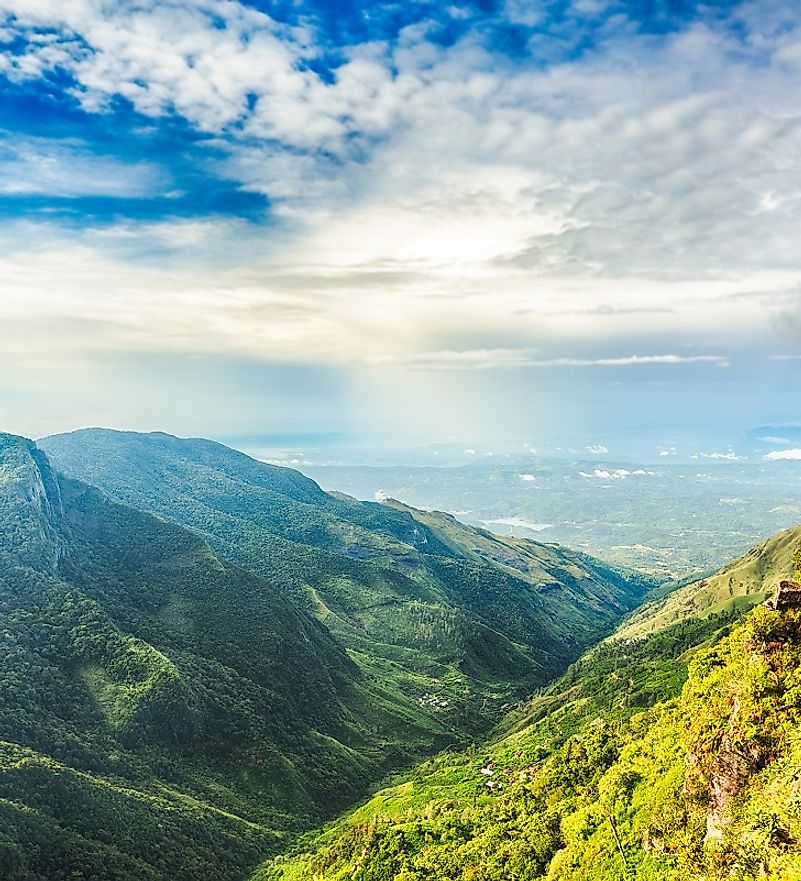Ecological Regions Of Sri Lanka

Sri Lanka is an island nation, and the region receives widely variable precipitation patterns. Although the country is forested it has a diverse and unique ecology due to years of isolation. Some of its flora and fauna are unique to its ecosystem. The ecological regions of Sri Lanka, according to the World Wide Fund for Nature are discussed below.
Sri Lanka Lowland Rainforests
The Sri Lanka Lowland Rainforests ecoregion is classified in the Tropical and Subtropical Moist Broadleaf Forests Biome. The forests in this region rise to almost 1,000 meters above sea level. The area enjoys even rainfall throughout the year, and its climate is mostly warm and wet. Temperatures range between 27 to 30 degrees Celsius throughout the year. This ecoregion is home to a rich and diverse flora and fauna. Years of physical isolation of the Island led to the development of a unique ecology in the Island. Different animals and plants are specially adapted to the conditions of the forests. The Flora of the region is dominated by two families namely Dipterocarpus and Mesua-Shorea. There are 306 tree species of trees and 60% of these are endemic to the region.
Mammals found here include Asian elephants, the Sri Lanka Leopard, Indian hares, and the Rusty-spotted cat. The region is home to the endemic mammal, the jungle shrew. The region is home to a variety of bird species including the White-throated Flowerpecker and the Green-billed Coucal which are endemic to the area. The region is home to the highest amphibian density in the world such as numerous frog species and over 200 species of reptiles. A substantial part of the fauna is listed as endangered. The area has been under threat due to human activities such as poaching, deforestation, and plantations. Efforts to curb this environmental degradation include the Sinharaja Forest Reserve and the Peak Wilderness Sanctuary.
Sri Lanka Montane Forests
The Sri Lanka Montane Forests are classified in the Tropical and Subtropical Moist Broadleaf Forests biome. The region encompasses montane and submontane moist forests rising to over 1000 meters above sea level. The forests are concentrated in the northeastern part of the Knuckles Mountain Range and the Central Massif. The rainfall in the region falls between 2,500 and 5,000 millimeters annually. Floral communities are mainly Dipterocarpus montane forests and savanna montane forests.
Fauna in the area exhibit higher levels of endemism than those in the lowlands. The region is home to 5 complete endemic and eight near-endemic mammals including the Asian Highland screw, the Dusky Palm squirrel, and the Purple-faced langur. The Sri Lanka Leopard and five rodents are listed as endangered species. Numerous birds, amphibians, and reptiles also live in the region. The forests have always been threatened due to mining, deforestation, and plantations. Ecological reserves in the area include Horton Plains National Park, Peak Wilderness Sanctuary, and Hakgala Strict Nature Reserve.
Sri Lanka Dry-Zone Dry Evergreen Forests
This ecoregion is classified in the Tropical and Subtropical Dry Broadleaf Forests Biome. It is characterized by evergreen forests and thorny scrubs spread in a flat land. Dominant tree communities in the area are Chloroxylon sweitenia, Vitex altissima, and Manilkara hexandra. These trees do not shed their leaves in the dry season a characteristic also exhibited by some forests in India.
The expanse is home to large populations of elephants, many of which are protected in individual zones. The Sri Lanka leopard, purple-faced leaf monkey, sloth bear and the slender loris are endangered mammals in the region. The ecoregion is home to more than 200 bird species and numerous reptiles. The climate of the area is largely dry, with rainfall between 1,500 millimeters and 2,00 millimeters, mostly falling from December to March. Around three-quarters of the forests have been destroyed through deforestation, human settlement, and agriculture. The region’s biodiversity has been protected in areas such as the Ruhuna and Wasgomuwa National Parks.
Deccan Thorn Scrub Forests
The Deccan Thorn Shrub Forests in Sri Lanka are classified as falling under the Deserts and Xeric Shrublands Biome. This region is situated in the Deccan Plateau in parts of India and Sri Lanka. The climate is mostly dry, with rainfall ranging below 750 millimeters, and mainly comes between December and March. Most of the indigenous forests have been cleared. The remaining part of the forest is the tropical thorn shrubs and some dry deciduous trees.
Over 90 mammal species roam the region, including endangered ones such as the sloth bear, tiger, blackbuck, and the dhole. There are nearly 350 bird species found in the region some of which are near-endemic while others are endangered. The area continues to be threatened by overgrazing and land transformation. There are some small reserves in the ecoregion aimed to protect the region’s ecology.
Conserving Sri Lanka's Ecological Integrity
Other ecoregions in Sri Lanka are the Sri Lankan Wet Zone, the Sri Lankan dry zone, the Southwestern Sri Lanka Rivers and Streams, and the Wet and South Indian Shelf. While Sri Lanka continues to boast a rich biodiversity, more efforts are required to safeguard the environment. Urgent and sound management practices are needed to preserve Sri Lanka’s unique flora and fauna.
Ecological Regions Of Sri Lanka
| Ecological Regions of Sri Lanka (as per World Wide Fund for Nature) | Biome |
|---|---|
| Sri Lanka Lowland Rain Forests | Tropical and Subtropical Moist Broadleaf Forests |
| Sri Lanka Montane Rain Forests | Tropical and Subtropical Moist Broadleaf Forests |
| Sri Lanka Dry Zone Dry Evergreen Forests | Tropical and Subtropical Dry Broadleaf Forests |
| Deccan Thorn Scrub Forests | Deserts and Xeric Shrublands |
| Sri Lankan Wet Zone | Freshwater |
| Sri Lankan Dry Zone | Freshwater |
| Southwestern Sri Lanka Rivers and Streams | Freshwater |
| West and South Indian Shelf | Marine |







